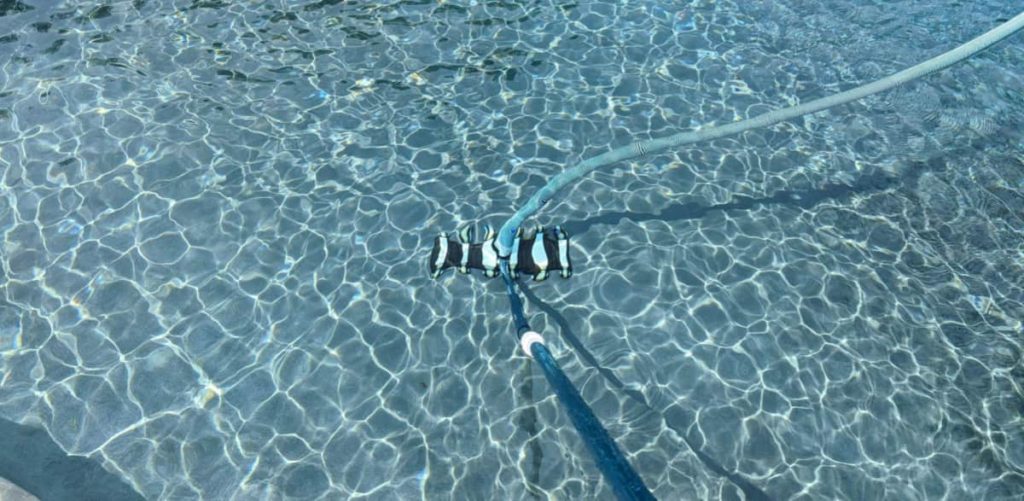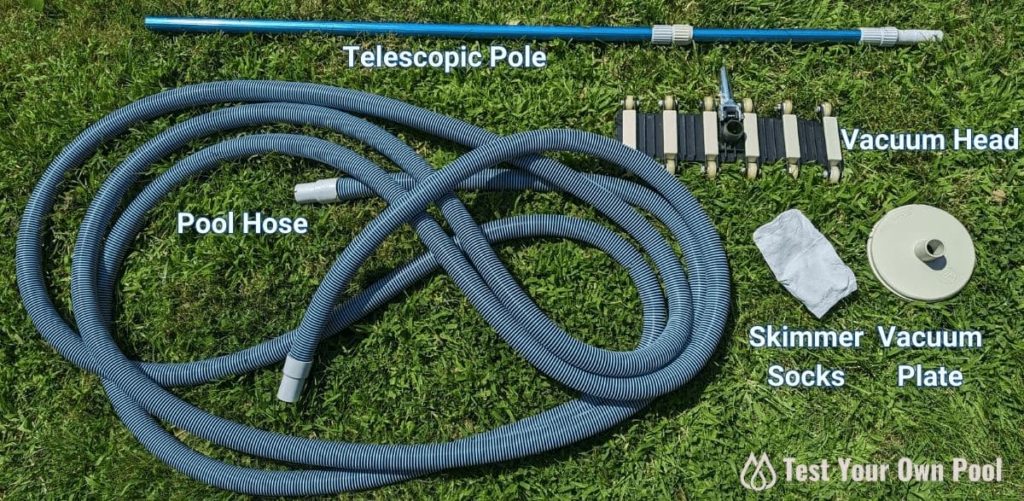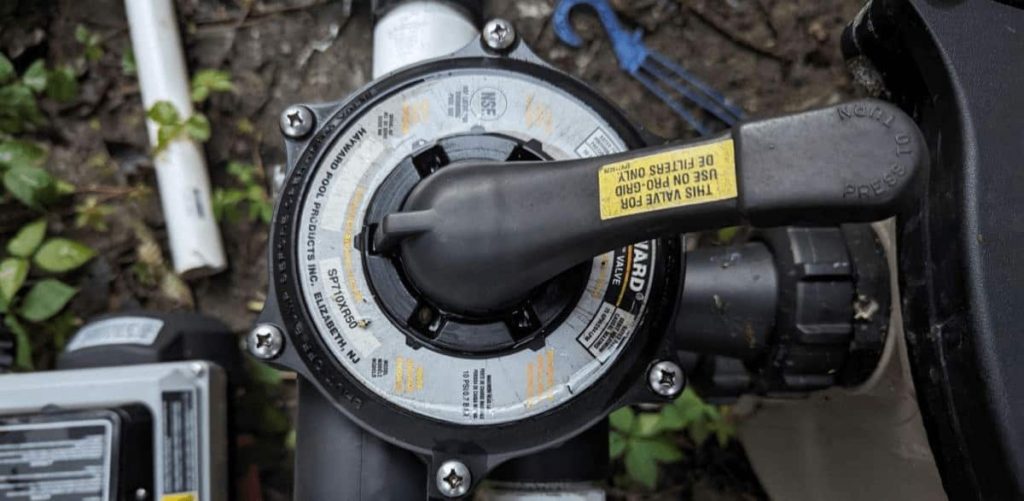Every pool owner should know how to vacuum a pool. Even if you have a pool robot that does most of the cleaning for you, there may be times when manual cleaning is necessary.
Vacuuming isn’t too complicated, but there are a few items to remember about setting up the vacuum and the filter settings (depending on your filter).

Items Needed to Vacuum a Pool
There is a high chance you have all the necessary items to vacuum. If not, they are everyday items a pool owner should have!
- Vacuum Head: There are different kinds of vacuums depending on your pool’s finish
- Roller (on wheels): Typically used for concrete and gunite pools. It also can be used with fiberglass.
- Brush: Used for vinyl and also fiberglass pools
- Telescopic Pole
- Pool Hose
- Vacuum Plate (optional)
- Skimmer socks (optional)

You want to ensure the telescopic pole and hose are long enough to reach every square foot of the pool.
Using a vacuum plate and skimmer socks allows you to suck in all the debris directly into the skimmer basket rather than the filter (if you aren’t vacuuming the pool to waste). While it isn’t necessary, you won’t need to clean the filter as frequently when using these items.
READ: Pool Blaster Max Li Handheld Vacuum Review
Vacuum Preparation
The first item you’ll want to check is your pool pump and ensure it runs at a high enough speed to suck up all of the debris in the pool.
Running a variable-speed pump at around 2,400 RPMs should be good enough if you have a variable-speed pump.
If you have a diatomaceous earth (DE) or sand filter with a multiport valve, you can keep it on FILTER mode if using a vacuum plate or if the pool isn’t too dirty.

Pools that are very dirty with large pieces of debris or fighting an algae outbreak may want to set their valve to WASTE to send water directly out of the pool. Just remember this setting will lose water so be prepared to refill if necessary.
How to Hook Up and Use a Pool Vacuum
It’s now time to vacuum the pool. It isn’t difficult to vacuum, though it may take a bit of time, depending on your pool size.
Connect the Vacuum Head, Telescopic Pole, and Pool Hose
The first thing we need to do is hook up the pool vacuum. Your vacuum head should have an attachment for the telescopic pole. Connect those until the pole is snapped into place.
Next, find the end of the pool hose that can spin. It might even have directions on which side to attach to the hose. Connect that side to the top of the vacuum head. Tug at it to ensure it is tight and won’t easily separate.
Once this is done, the vacuum is ready to go!
Submerge Vacuum Into Pool and Fill Hose with Water
Put the vacuum somewhere into the pool where it won’t move too much without holding it. It’s easiest to let it go to the bottom of the pool and have the pole rest on the pool coping.
We want all the air removed from the pool hose because we won’t want the pool pump to suck in any air and cause potential damage. To do this, take the open end of the pool hose and set it against a return jet. This ensures all the air gets pushed out and replaced with water.
You’ll know it’s working when the vacuum head blows air bubbles. It might want to force itself up from the pressure, but that is OK. Once the air bubbles have stopped, the hose is full of water.
Attach the Hose to the Skimmer Port (or Basket)
If you use a vacuum plate and skimmer socks, wrap the sock around the skimmer basket and set the basket back into the skimmer. Attach the vacuum plate to the hose end on the return jet. Ensure it stays in the water so air doesn’t get in. Once ready, set it on top of the skimmer basket. There should be a tight seal.
If no plate is being used, remove the skimmer basket so you can see the suction port beneath. Take the open end of the hose and place it into the port. Tug at it to ensure it is firmly sealed.
Time to Vacuum the Pool!
And now the fun begins! It’s recommended to start at the shallow end and work your way to the deep end.
When vacuuming, try and overlap your pattern so everything is gathered. Go slow and methodical so dirt and debris don’t get too disturbed. Remember, the goal is to get everything on the walls and bottom of the pool.
If the vacuum loses suction, repeat the above steps to start again. You may notice the skimmer sock or filter is full. If that is the case, dump the debris in the sock or clean the filter (a backwash may be necessary).
Cleaning Up
When you are done, first remove the hose from the skimmer. Once disconnected, take the vacuum out of the pool.
To prolong the life of your cleaning equipment, wash it down with a hose. This cleans all the equipment of pool chemicals.
Once dry, return it to storage or on the pool fence where it will be ready for next time!
Different Types of Pool Vacuums
There are a few different ways a pool can be vacuumed, each with the same goal of keeping it clean!
- Suction-side vacuuming is what was described above. It uses a vacuum that is connected through the part of the pool that sucks in water. This is through the skimmer port. When using a suction-side cleaner, consider shutting off the valve to the main drain to increase suction pressure from the skimmers.
- Pressure-side vacuuming is connected to the pressure or return side, the part that pushes water back into the pool. This is either through a dedicated pool port or the return jet port. This vacuuming pushes and disturbs the debris into a vacuum connected to a big net to catch everything.
- Robotic cleaners are fully automated vacuums that are more like “set it and forget it.” They are either totally freestanding of hoses or can be both pressure- and suction-side cleaners. While they are more expensive than manual vacuums, the time saved may be worth it in the long run.
How Often Should I Vacuum the Pool?
A nice deep pool clean should be part of a weekly routine. This includes brushing and skimming the pool, along with vacuuming.
If you find yourself cleaning daily based on factors out of your control, it might be time to start thinking about a pool robot to save you some time and energy.
Cleanliness is Happiness!
There is nothing quite like a clean pool! While it can be meticulous and take a long time, knowing how to vacuum a pool is an important part of the overall maintenance and health of the pool’s water.
Keep it clean and keep on swimming!
